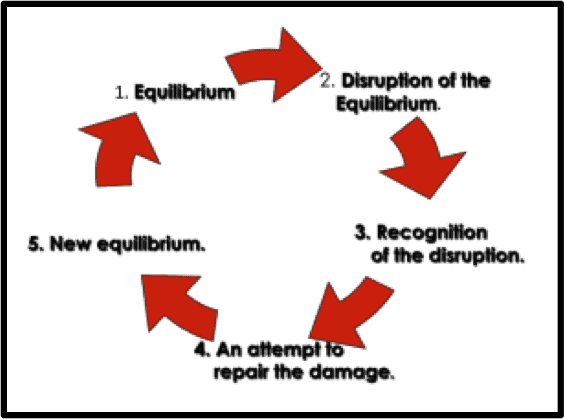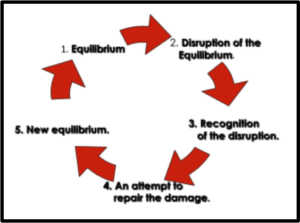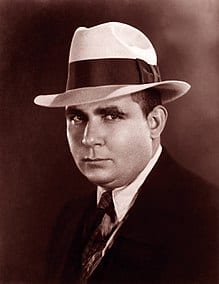This blog post explores the Todorov Model of narrative. It is the fifth in a series of story structure posts analysing Robert E Howard’s celebrated story, ‘The Tower of the Elephant’, which is summarised here. The previous posts deal with the following models or processes:
The Todorov Model
In 1969, the Bulgarian structuralist linguist Izvetan Todorov first introduced the idea that stories start in a state of equilibrium then suffer a disruption, after which a series of events occurs to restore the world either to its old state of equilibrium or, what’s more likely, to a new state. These stages are set out below:
- A state of equilibrium at the outset.
- A disruption of the equilibrium by some action.
- A recognition there has been a disruption.
- An attempt or attempts to repair the disruption.
- A reinstatement of equilibrium.
As is shown below, this model can be applied to the overall plot of a story and also to individual scenes.
Initial Equilibrium
The state of the world in which the Yag-kosha is trapped by the high priest, Yara, who, through the power of Yag-kosha, holds the kingdom of Zamora in thrall. And in the midst of this situation is Conan, a ‘tall, strongly made youth’, who is in a tavern of the Maul and possibly in a state of need, either of funds to live in the Maul or, more likely, of a task to prove to himself (and others?) who and what he is.
As for individual scenes, states of equilibrium would include moments before the need for action, as when Conan meets Taurus and they are then confronted by the lions, and moments after a period of action, as when Conan defeats the giant black spider and is looking for the treasure.
Disruption
The Kothian slave trader reminds the whole tavern of the existence of the treasure, ‘the secret of the Elephant’s Tower’. Suddenly, the world has changed. The treasure represents to Conan a chance for funds and/or reputation through an act of prowess. We rarely enter the mind of Conan at this point in the story, so we don’t really know his true motivation for the task other than, quite possibly, to prove to the Kothian and all the other boasters and hangers-on in the tavern that he is not like them, that he is a ‘real man’.
Disruptions to scene equilibriums within the story itself would include the sudden appearance of the lions, the unexpected death of Taurus, and the revelation that the statue of the Elephant is alive.
Recognition
This happens virtually at the same time as the Kothian slave trader’s pronouncement. This part of the story is depicted from the Kothian’s point of view, so we don’t actually see Conan’s reaction to the news. The first sight of Conan in the story is the hand that touches the Kothian slave trader’s shoulder in order to get his attention and interrogate him about the secret of the tower, about which he has already heard much.
As for individual scenes, recognitions of the need to address a change to equilibrium, usually occur after the appearance of a threat. Such recognitions are almost simultaneous with the threat and the action taken against it, as with the appearance of the lions and the black spider.
Attempts to Repair the Disruption
Given that the initial disruption was the challenge of gaining treasure (and reputation?), the robbery attempt itself is the main attempt at repair the ‘disruption’. The robbery involves a number of stages (complications): climbing the wall, defeating the lions, climbing the tower, defeating the spider creature, and encountering the idol.
At this point in the story, a new disruption appears: the realisation that the treasure is not a thing, but a being from the edge of the universe, a being who has been coldly imprisoned and misused. This disruption to his plans takes some time for Conan to recognise, as Yag-kosha explains his history and his imprisonment. Conan has to weigh his original goal with a new one. He recognises the need to address a wrong and does so immediately: the warrior forgoes his thievery mission, follows Yag-kosha’s directive, and helps the being enact its revenge on Yara.
Reinstatement of the Equilibrium or a New Equilibrium
Naturally enough, with the death of Yara and the destruction of his tower, a new equilibrium results: the Zamorian kingdom has lost its oppressor. Also, Yag-kosha , who is now Yogah of Yag, is free to return to his home dimension. The aspect of the old equilibrium that remains is Conan’s monetary state: he left the tower without any treasure.
Yet, as in all good stories, Conan has changed. Although he did not succeed in his original mission—the gaining of treasure—and no one is likely to know his part in the destruction of Yara and the freeing of the kingdom (unless he brags about this, which he is unlikely to do), Conan has gained an internal prize: the awareness of his capacity for pity, for compassion.
Conan at the start of the story is young and impulsive, but the situation with Yag-kosha brought out something he may not have realised he had, or would not have thought a warrior of Crom should have: empathy. In this, he is contrasted with his god, who ‘sent forth dooms and death’ and ‘was a gloomy, savage god’ who ‘hated weaklings’. Crom gave him ‘courage at birth, and the will and might to kill his enemies’, but would not have given him compassion. That came from somewhere else. Although the appearance of such a quality meant Conan walked away from the adventure without treasure (one can’t envision Taurus having made a similar decision, if given the choice), the awareness of emotional depth in himself is likely to be of help in other adventures.
For Zamora itself there is a new equilibrium: existence without the tyrant. This implies that the original disruption was Yara’s appearance in Zamora 300 years earlier. After the fall of the Tower of the Elephant, the new political equilibrium is much the same as the one before Yara’s appearance.
Series Purpose
After examining six models (with more still to come), I thought it best to discuss what I hope people might get out of this series.
For Writers
My original intent for exploring story structure was obviously to discover techniques that might be useful for my own writing. There is a ton of advice out there, some of it contradictory, all of it useful once you separate the universal truths from that particular author’s or critic’s colouring of it or their biases.
I’m not saying I have decoded all that there is to know, far from it, but this ongoing exploration has been giving me processes for creation and for editing stories. What more can I ask more? Naturally, if other writers out there need help to identify, understand, or use such models for their own work, I hope my series provides them with pertinent details and a worthwhile application to a story with a strong reputation in its genre.
For Readers
Although writers are readers (or should be, if they want to write well), readers may not be writers, other than in the imaginative process they bring to bear when experiencing a text. So, what benefits can readers receive from an awareness of models of story structure?
Even though I originally applied the models to Robert E Howard’s story as a way of showing how the story illustrates the models in action, what also came out of the analyses have been insights into the story itself, insights I might not have had when purely reading and re-reading the story.
Readers might choose to engage with the story only, rather than look at a critic’s analysis or apply their own analysis. That’s their choice. For those readers, however, who have time and the inclination to understand what happens ‘behind the curtain’ and would like to discover nuances in the story that might not be apparent on a pure read, then I hope the models in the series and my application of them will help them in their applications.
If you see any other benefits that the series might bring or would like me to consider your own pet model, please let me know in the comments. Thanks in advance.
Be safe, well and inspired!
Cofion cynnes (Warm wishes)
Earl
______________________________________________________






2 Comments